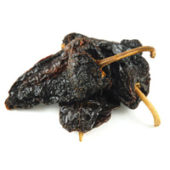In Mexico, the ancho is marketed in three grades of quality. “Primero” is the highest grade, consisting of the thickest-fleshed and largest chilies. “Mediano” is the medium grade and “Ancho” is the basic grade. Of the dried ancho crop, about 15% is market as food coloring and powder. The remainder is purchased by consumers in whole-pods and used mainly in sauces. Ancho chilies account for nearly 1/5 of all chilies consumed in Mexico.
Varying in color and form, dark brick red to deep mahogany, dried ancho chilies reveal a reddish-orange cordovan tint when held up to the light. Mildly aromatic, flat, very wrinkled and appearing almost heart-shaped, the ancho is a dried poblano pepper and is the sweetest dried chili. At its best, when aromatic and flexible, it has a medium-thick flesh that offers a somewhat fruity-sweet-woodsy flavor with tones of dried plum, coffee, tobacco, liquorice and raisin. It gives a sweet plum-raising-like flavor to dishes. Named for its characteristic broad shoulders, “Ancho”, pronounced AHN-CHOH, means wide in Spanish.
Capsicums chilies contain more vitamin A than any other food plant, plus provide an excellent source of vitamin C and B, plus significant amounts of iron, thiamine, niacin, magnesium and riboflavin. Conforming to today’s nutritional awareness, chilies are cholesterol—free, saturated fat-free, low calorie, low sodium and high in fiber.
Add their sweet flavor to cooked sauces. Use like sun-dried tomatoes. Used in combination with other dried chilies, this pepper’s rich sweetness has a mellowing effect. Sprinkle chopped or sliced chilies on foods for an exquisite flavor and color. Enhance meat and poultry, vegetables, casseroles, dips, soups and stews. Add a zip to chili con carne, enchiladas, adobados, or any meat prepared with a sour seasoning paste. Commercially, anchos are ground.
Depending on the region, this chili is known by several names. Confusion exists in the United States over the correct name for the ancho. Growers mistakenly call both fresh and dried forms “ancho”. In Mexico, the unripe green pepper is never referred to as “ancho”. In California, it is often confused with the pasilla chile. Anchos actually are dried poblano chilies, meaning “People” chilies. The dried ancho, together with the mulato and the real pasilla chilies, form the “Holy Trinity” of chilies used in traditional Mexican mole sauces.









